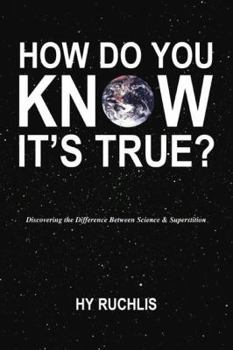How Do You Know It's True?
Superstition still requires that many buildings have no floor numbered thirteen. More than 25% of Americans say they believe in astrology. Knocking on wood is an almost universal habit. Are these harmless notions - or dangerous delusions? Unfortunately, "fairy-tale thinking" is still the greatest enemy of progress, and education often bypasses the teaching of cognitive skills young readers can use to think independently.How Do You Know It's True?...
Format:Paperback
Language:English
ISBN:0879756578
ISBN13:9780879756574
Release Date:August 1991
Publisher:Prometheus Books
Length:112 Pages
Weight:0.50 lbs.
Dimensions:0.3" x 5.4" x 8.5"
Age Range:12 years and up
Grade Range:Grade 7 and higher
Customer Reviews
5 ratings
Well written for kids and adults
Published by Thriftbooks.com User , 17 years ago
Great book on teaching children how to think using logic and reason before coming to a conclusion. I think that this book or one just like it should be required for grade school kids. There are too many people seduced by superstitions, scams, and supernatural beings. Critical thinking classes are usually required in college, but not many people are given the chance to learn about the subject before that age. Most people hear about things like fortune telling, ghosts, and religions in childhood. Grade school is usually way before kids can make an educated conclusion about those topics unless they were taught to think critically early on in their education. The book has great true examples to illustrate how believing that supernatural things like demons or witches really exist can be dangerous.
This book should be required reading at schools!
Published by Thriftbooks.com User , 22 years ago
This is an excellent book. It really does a number on superstition! I can't imagine anyone reading this book would still be superstitious. And since far too many people waste time and money on superstition (I couldn't believe one of our PRESIDENTS would change his schedule based on superstition), putting the axe in this kind of thinking at a young age, would benefit everybody (as the book so well explains).My 8 year old was very curious about this book. I could let her read some of it, but since she has not yet learned division and multiplication, the section on probability would be completely lost on her, which is a shame, since the probability theory so well explains unusual events. This is important, since so many superstitious people would attribute the unusual events to something superstitious; using probability to explain these events defuses their so-called "proofs".My daughter will have to wait for a while, but she will definitely read it when she is older (and so will my other - younger - daughters). This is a must for every schoolkid 10 or older (actually, it's a must for just about anybody with any superstitious tendencies, including those who believe in horoscopes).
Mike in TN
Published by Thriftbooks.com User , 23 years ago
This is a wonderful book about scientific thinking for kids older than 10. Warning to parents: this book does a number on Santa! My son (younger and not yet de-mythed) enjoyed the book immensely. I read it to him and skipped the offending paragraphs. Had the author skipped the Santa stuff this book would be great for gifted/talented kids who are much younger -- the writing is that clear and engaging!
Explains to Young Adults Why Critical Thinking Works!
Published by Thriftbooks.com User , 27 years ago
Excellent introductory book on the acquisition of knowledge, with special emphasis on the reliability and utility of the scientific method. A must read for children. I would also recommend it to older adults who are lacking in knowledge concerning the scientific method and how sound logic and reasoning is applied.
Immunizing yourself vs. superstition and uncritical thinking
Published by Thriftbooks.com User , 27 years ago
HOW DO WE KNOW IT'S TRUE by Hy Ruchlis. Far and away the best of the best of new releases for teaching critical thinking to young people. Actually, this is for anybody, young or old, who still has a tendency to flirt with any form of superstition or fairy-tale thinking or is curious why other people do so. Ruchlis patiently leads the reader through an appreciation of science as a way of thinking about the world we live in. A short history of superstitions and the occasional horrors attributed to magical thinking (e.g., fear and persecution of "witches)" are provided, along with a delightful and entertaining commentary on astrology as an example of worseness tendencies in contemporary mental processes. Highlights include an explanation of science as a way of thinking critically, with examples of how facts are discovered. Vital to an understanding of why there is so much superstition and other forms of magical thinking is to know the history of religious repression of free thought, with stories about the struggles of such heroes of science as Nicolas Copernicus, Giordano Bruno, Galileo Galilei and the framers of our own Bill of Rights in 1789. By the way, the photos and illustrations are also terrific. But, it's words like the following that lead me to urge that you check this one out if you want to incorporate CT into wellness: "All of us stand on the shoulders of giants. Every bit of food we eat, the clothes we wear, the houses we live in and anything else we know how to make or do today would not be possible without the knowledge given to us by people who lived in the past. We must be ever grateful to the many thousands of people, past and present, who made it all possible. What part of these great accomplishments has been contributed by the superstitious way of thinking? Absolutely nothing. The belief in fairy-tale magichas blocked attempts to explain how and why things happen. Today it is a lazy person's excuse to avoid thinking about why things happen."





